Chinese evergreen (Aglaonema) is a very popular houseplant among gardeners due to its easy care. However, it is a houseplant that does not require much care. Occasionally, the Chinese evergreen presents yellow leaves due to certain factors.
The most common causes of Chinese evergreen leaves turning yellow are watering stress, improper lighting conditions, pests, diseases, and foliage aging. In this article, I will explain the causes of yellow leaves on Chinese evergreens and how to fix them.
In addition, I will also explain how to prevent Chinese evergreen from having yellow leaves. Yellow leaves indicate that something is wrong with your plant, which is why I will explain how to prevent your Chinese evergreen from having yellow leaves.
Table of Contents
Why Are My Chinese Evergreen Leaves Turning Yellow
Why Are the Leaves on My Chinese Evergreen Turning Yellow? Chinese evergreen leaves turn yellow due to a variety of factors. The most common causes among gardeners who notice yellow leaves on their Chinese evergreen are watering stress and improper lighting. Of course, these are not the only causes of yellowing leaves on Chinese evergreen.
Here are some common reasons why the leaves of your Chinese evergreen might be turning yellow:
- Watering Stress
- Improper Light Conditions
- Pests and Diseases
- Aging Foliage
- Nutrient Deficiency
- Low Humidity
Throughout this article, I will go into more detail about the causes and how to fix yellow leaves on Chinese evergreens. Almost all these problems that cause yellow leaves have simple and inexpensive solutions. Please continue reading to learn all about yellow leaves on Chinese evergreen and how to fix them.
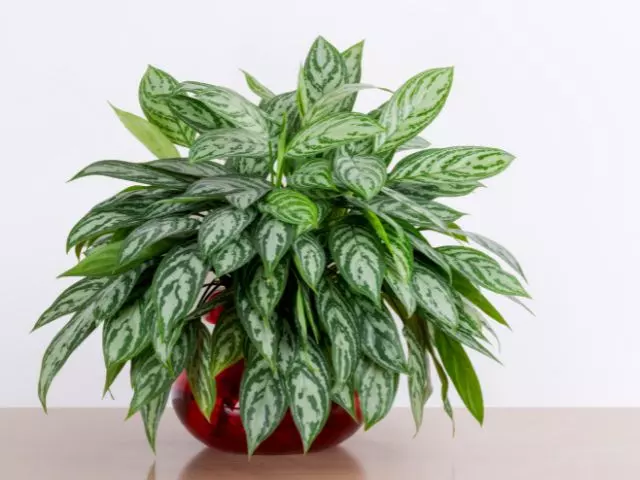
Chinese Evergreen Yellow Leaves Due to Watering Stress
I am absolutely sure that the number one cause of yellow leaves on Chinese evergreen is due to overwatering or underwatering. Before watering your Chinese evergreen, always check that the first two inches of the substrate are dry. You can use a moisture meter or insert a small stick in the soil; if it comes out with soil sticking to it, the substrate is still wet.
Overwatering causes the roots to suffocate and rot. So always check the substrate before watering. It is also essential that you use a well-draining substrate and that the pot has enough drainage holes to drain excess water properly.
On the other hand, lack of watering will also cause the leaves of your Chinese evergreen to turn yellow. The leaves turn yellow and even drop if the soil dries out entirely for extended periods. Prevent the soil from drying out completely and control the substrate’s moisture.
If you notice that your Chinese evergreen has a problem with overwatering, the best thing to do is to repot it to a new substrate. When repotting, check the roots; if you notice any root rot, remove it. Use a new substrate with good drainage to save your plant.
Chinese Evergreen Yellow Leaves Due to Improper Light Conditions
Improper lighting is the second most common cause of yellow leaves on Chinese evergreen. Chinese Evergreen can tolerate low light conditions but thrive in bright, indirect light. If your plant is in very low light, it may not be able to photosynthesize properly, leading to yellowing leaves. Also, plants that receive less light grow slower and absorb less water, which will cause other problems.
In addition, some varieties of Aglaonema require more light than others, but always indirect lighting. For example, Aglaonema commutatum Variegated needs more light than the white-leaved varieties, which can grow with less light.
Chinese evergreen thrives in various lighting conditions but are particularly sensitive to direct sunlight. Excessive exposure to direct sunlight can cause the leaves to brown and curl, resembling burning effects.
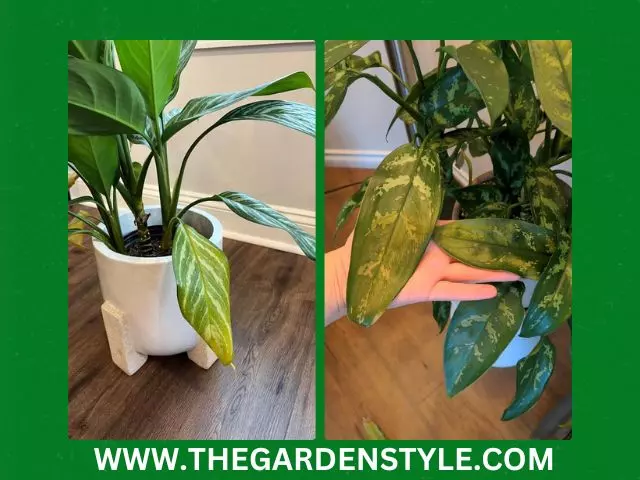
Chinese Evergreen Yellow Leaves Due to Pests and Diseases
Pests and diseases also cause yellow and brown leaves on Chinese evergreen plants. Check the plant for any insects on the leaves or in the substrate that are affecting your plant. Mealybugs and aphids are often visible as white or greenish clusters, while spider mites may leave fine webbing.
If you notice any insects on your plant, the first thing to do is to separate the plant from the others to prevent them from spreading to other plants in your home. You can use neem oil to eliminate aphids, mealybugs, and other insects that affect your Chinese evergreen. Learn more about how to mix neem oil for plants.
It is also possible that you are observing scale insects on your plant. These pests often appear as small, round, or oval bumps on leaves and stems. Gently scrape them off with a soft brush or cotton swab dipped in rubbing alcohol. I recommend you read this article to identify mealybugs and scale insects correctly.
Chinese evergreen leaves also turn yellow due to diseases such as fungal infections, bacterial infections, and root rot. Yellowing leaves with brown spots or mold-like growth can indicate fungal infections. Improve air circulation, avoid overwatering, and consider applying a fungicide.
Bacterial infections can cause yellowing and wilting of leaves on Chinese evergreen. Remove affected leaves and maintain good sanitation practices. Make sure your plant is not exposed to excess moisture.
Yellowing leaves can signify root rot caused by overly wet soil. Remove the plant from its pot, trim away affected roots, and repot it in fresh, well-draining soil. Adjust your watering habits to prevent further root rot.
Chinese Evergreen Yellow Leaves Due to Aging Foliage
Chinese evergreen yellow leaves at the bottom. Suppose you notice just a few yellow leaves towards the bottom of your Chinese evergreen. In that case, it is generally considered a normal occurrence. Older leaves naturally turn yellow and drop off as the plant matures. That is normal, and as long as new growth is healthy, there is usually no need to worry.
It is more common for the leaves of your Chinese evergreen to turn yellow in the fall and winter because light levels decrease.
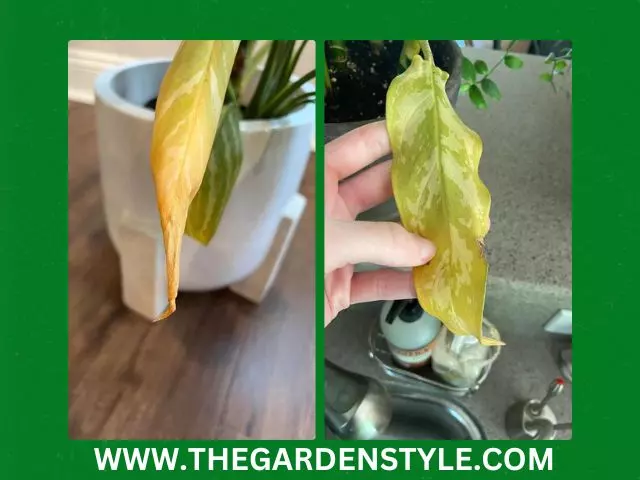
Nutrient Deficiency Causing Chinese Evergreen Leaves Turning Yellow
Nutrient deficiency in plants causes yellow leaves. Yellow leaves on Chinese evergreen due to a lack of nutrients in the substrate is quite low but not impossible. If you recently repotted your Chinese evergreen, it will likely not need fertilizer for a year because the new substrate has all the necessary nutrients.
On the other hand, if you have the same pot and substrate, your Chinese evergreen may have yellow leaves due to a lack of nutrients. Use an NPK 3-1-2 fertilizer for indoor plants. Apply the fertilizer according to the manufacturer’s directions.
To avoid yellow leaves on your Aglaonema, I recommend fertilizing at least during the spring following the manufacturer’s instructions. That will ensure the substrate has the nutrients your Chinese evergreen needs to develop properly.
- Indoor Plant Food
Low Humidity Causing Chinese Evergreen Leaves Turning Yellow
Chinese evergreen prefers higher humidity levels. The leaves can turn yellow in dry indoor environments, especially during the winter months when indoor heating is running. You can increase humidity by misting the plant, using a humidity tray, or placing a humidifier nearby.
Also, you can group several plants together to improve humidity levels, increasing transpiration and improving humidity levels. That creates a microclimate where moisture released by one plant benefits the others.
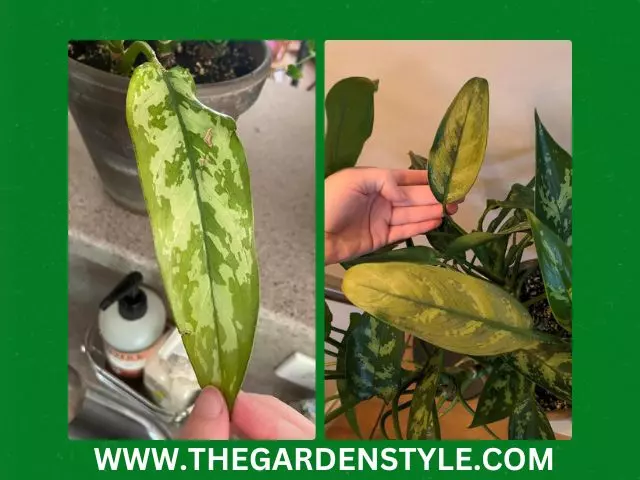
FAQ About Yellowing Chinese Evergreen Plant Leaves
Should I Cut Yellow Leaves Off Chinese Evergreen?
Yes, cutting off yellow leaves from your Chinese evergreen is a good idea. Yellowed leaves will not recover, so I recommend cutting those leaves that take energy away from the plant. Use disinfected scissors to remove the leaf carefully.
Can Yellow Chinese Evergreen Plant Leaves Turn Green Again?
No, yellow leaves will not turn green again. Once a leaf has turned yellow, it is a sign that the cells in that leaf are no longer functioning effectively. The green chlorophyll pigment, responsible for the green color, has broken down or diminished significantly.
Why Are My Chinese Evergreen Leaves Turning Yellow and Brown?
When your Chinese evergreen plant’s leaves start showing a yellow, crispy brown appearance, it is a sign that it requires increased moisture or higher humidity levels. However, if the leaves appear mushy, brown, and yellow, it could indicate overwatering, leading to potential root rot.
Chinese Evergreen Yellow Leaves After Repotting
Yellowing leaves may be a sign of stress or adaptation, which can be triggered when a plant is repotted. Ensure the plant has proper drainage, receives the correct amount of watering (neither excessive nor insufficient), and is exposed to sufficient light during this transition.
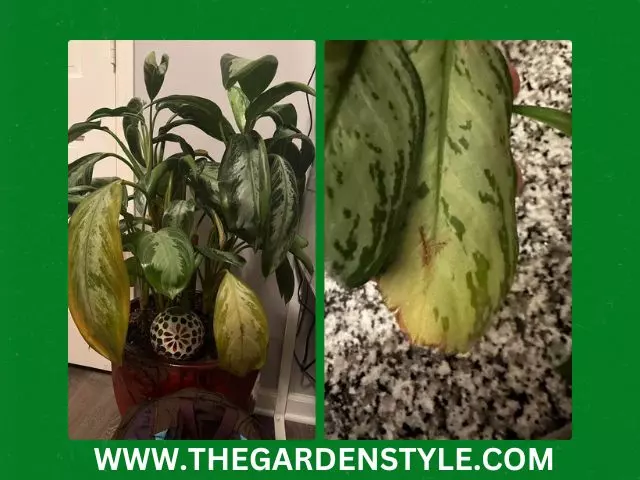
Final Conclusions
Yellow leaves on Chinese evergreen plants are due to several factors, such as watering stress, improper light, diseases, pests, aging foliage, nutrient deficiency, and low humidity. Fortunately, most of these problems can be easily fixed. As a general rule, the best way to avoid the yellowing of leaves on your Chinese evergreen is to control watering. Excessive watering causes diseases and pests.
The first question I ask any gardener who tells me their plant has yellow leaves is, “How often do you water your plant?” I usually find out the problem is overwatering. I hope this article is helpful, and if you still have any questions, please do not hesitate to contact us through the contact form. If you are passionate about houseplants, I recommend you to read our article on the best indoor plants for home decor.


